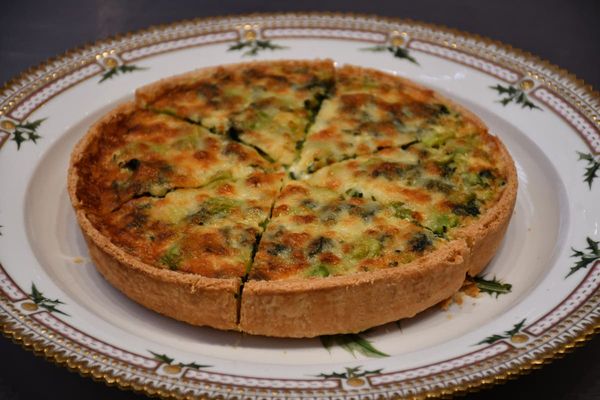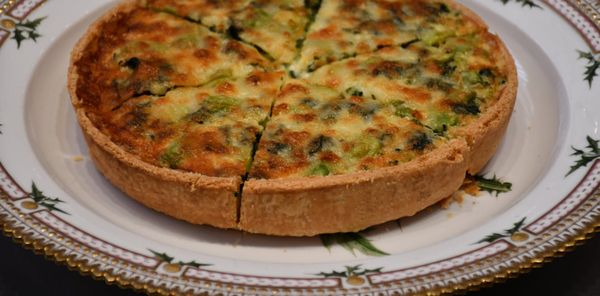
It would be good to say that the recipe for the coronation quiche to mark the forthcoming ceremony looks delicious, nutritious, and is a true celebration of British food and vegies, as well as something the average subject of King Charles can grow in their backyard, to help with the cost of living.
Sadly, that isn't the case. It actually looks pretty yuck, with a wide, tough-looking crust that appears to weigh a kilo and might add a kilo to your waistline if you eat it. But at least the filling's main ingredients can be grown at home: spinach, tarragon and broad beans. You even have time to plant and harvest them in time to make the quiche for the coronation, if you plant them now. The filling, in fact, might be quite tasty if you cook it without the crust.
Spinach will germinate at lower temperatures than most green veg. It's tender, slightly sweet in winter and cool springs, and so good when home grown. Plant it now, as if we don't get a warm early May, the seeds may not germinate. Better yet, buy seedlings and keep them well fed with seaweed-based foliar spray.
Bung in the broad beans now, too. Traditionally they should be planted in May in this climate, but I've found they grow better, stronger and give more beans if planted earlier, so they get some decent growth before winter. Broad bean plants stop growing in the cold, but zap upwards in spring, bearing many flowers up and down their long stems. If you have only ever eaten frozen broad beans, you'll find young broad beans a revelation: they're sweet and tender.
Broad beans seem to grow best with a light - very light - sprinkle of wood ash on the soil when they are young. Feed them only while they are actively growing, and stake them if they're in a windy spot - two to four stems to one stake will do, or grow them in rows between two strings.
Now for the tarragon, a delicate aniseed-flavoured herb that does well with anything creamy, like the cheese and cream in this quiche, or even scattered over a poached egg on buttered toast. This is a terrible time to plant it, as it will become dormant as soon as the weather gets colder, only poking its head out in spring. French or "true" tarragon doesn't grow from seeds, like the tasteless Russian tarragon often sold as tarragon - sniff for aniseed before you buy. Keep it in a pot in a sunny spot, as it's easy overwhelmed by weeds. Russian tarragon grows prolifically, even if its flavour is just "vaguely green". True tarragon tends to vanish overnight, probably eaten by snails, slugs, or dead from wilt or even gathered by elves for midnight potions - all I know is that every tarragon plant I have planted has disappeared, often suddenly. But it's been delicious while it lasted.
As for the other ingredients: you could probably manage the cheese and cream if you keep a miniature backyard cow and have taken lessons in cheese making. Cottage cheese and cream cheese are easy to make. Good cheese takes knowledge and a starter. The flour is possible if you want to turn the front lawn into a wheat crop. But if you want the pork lard that binds the crust together, first catch your pig, preferably a feral one as Australia has too many feral pigs - even one would be too many - but they carry diseases and spread them to humans, so I definitely advise not cooking with their fat unless you really know what to do.
Adding lard to a quiche crust sounds gross to our modern tastes, but actually gives a moister, lighter and crisper result than butter. My grandmother cooked almost everything in the mutton fat drained from the pan in which mutton legs, shoulders, chops et al had been baked. Grandma was of the "Dripping for England" era, when Australians were urged to collect their dripping and send it to severely food-rationed England. Perhaps it's included in the recipe because Charles, who is older than I am, may remembers the post-war lard donations from the colonies across the oceans.
You might even like to revive the tradition, for this most traditional occasion, and send a package of the fat left over from your next roast, well-sealed and labelled "Dripping for Coronation", care of Buckingham Palace.
Just don't expect a thank you card.
PS: The last "coronation dish" was created by Constance Spry in 1953. Coronation chicken is glorious. I once made a vat of it for a wedding, but wouldn't these days, as it's based on homemade preservative-free mayonnaise which might go off if left out of the frige too long, posing a risk of food poisoning. You add just a hint of curry powder to the mayonnaise, plus pureed dried apricot, and fold in cold roast chicken stripped from the bone. That was in the days before frozen battery chooks and breeds bred to give "lots" rather than flavour or a long and happy life. Chicken back then was a rare treat, and coronation chicken was magnificent.
This week I am:
- Coaxing the spinach seedlings and accepting I planted the broccolini far too late to get a good crop this year.
- Watching the white and green hydrangea flowers turn green-pink, as they always do as the weather cools.
- Enjoying clouds of finches eating the grass seed in the lawn we haven't got around to mowing.
- Remodelling a downpipe that a wombat took a dislike to and destroyed, and then also broke the fence we put around it.
- Realising we're going to have an enormous crop of lemons and limes again this year, and broken branches if we don't keep picking them as they ripen.
- Delighted as a new patch of leaves turn colour every morning.
- Hoping the parsley plants left to go to seed actually produce ripe seed this cool and damp autumn.
We've made it a whole lot easier for you to have your say. Our new comment platform requires only one log-in to access articles and to join the discussion on The Canberra Times website. Find out how to register so you can enjoy civil, friendly and engaging discussions. See our moderation policy here.










